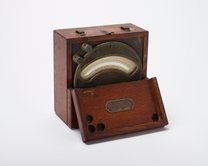Type 650-A Impedance Bridge
- After 1933

 This work is licensed under a Creative Commons Attribution 4.0 International License.
This work is licensed under a Creative Commons Attribution 4.0 International License.Rectangular wooden case with sloped top; black instrument panel on top surface; instrument panel features six connection posts for the external generator, a galvanometer meter under glass, nine black plastic knobs, four of which are mounted on metal scales, and five other metal connection posts along the right side and bottom; above the instrument panel is a wooden lid fastened by two screws; underneath the lid is an empty storage area; a black metal handle is on the top side of the wooden case.
Impedance bridges compare electrical impedances, which may contain inductance, capacitance, and resistance. They use a method similar to that employed by Wheatstone bridges, which use a four-arm bridge circuit to compare an unknown resistance to that of a known standard.
The Type 650-A was introduced in 1933 and was popular based on its flexibility and utility. The 650-A was one of the best-selling instruments by the General Radio Co. and sold for the low cost of $175. This particular instrument was previously used at the BASF (Baden Aniline and Soda Factory) dye laboratory in Rensselaer, New York.
| Property | Value |
|---|---|
| Manufacturer | |
| Place of manufacture | |
| Format | |
| Genre | |
| Medium | |
| Extent |
|
| Inscription |
|
| Subject | |
| Rights | Creative Commons Attribution 4.0 International License |
| Credit line |
|
Institutional location
| Department |
|---|
Related Items
Cite as
Science History Institute. Type 650-A Impedance Bridge. Photograph, 2016. Science History Institute. Philadelphia. https://digital.sciencehistory.org/works/jm214p20f.
This citation is automatically generated and may contain errors.






